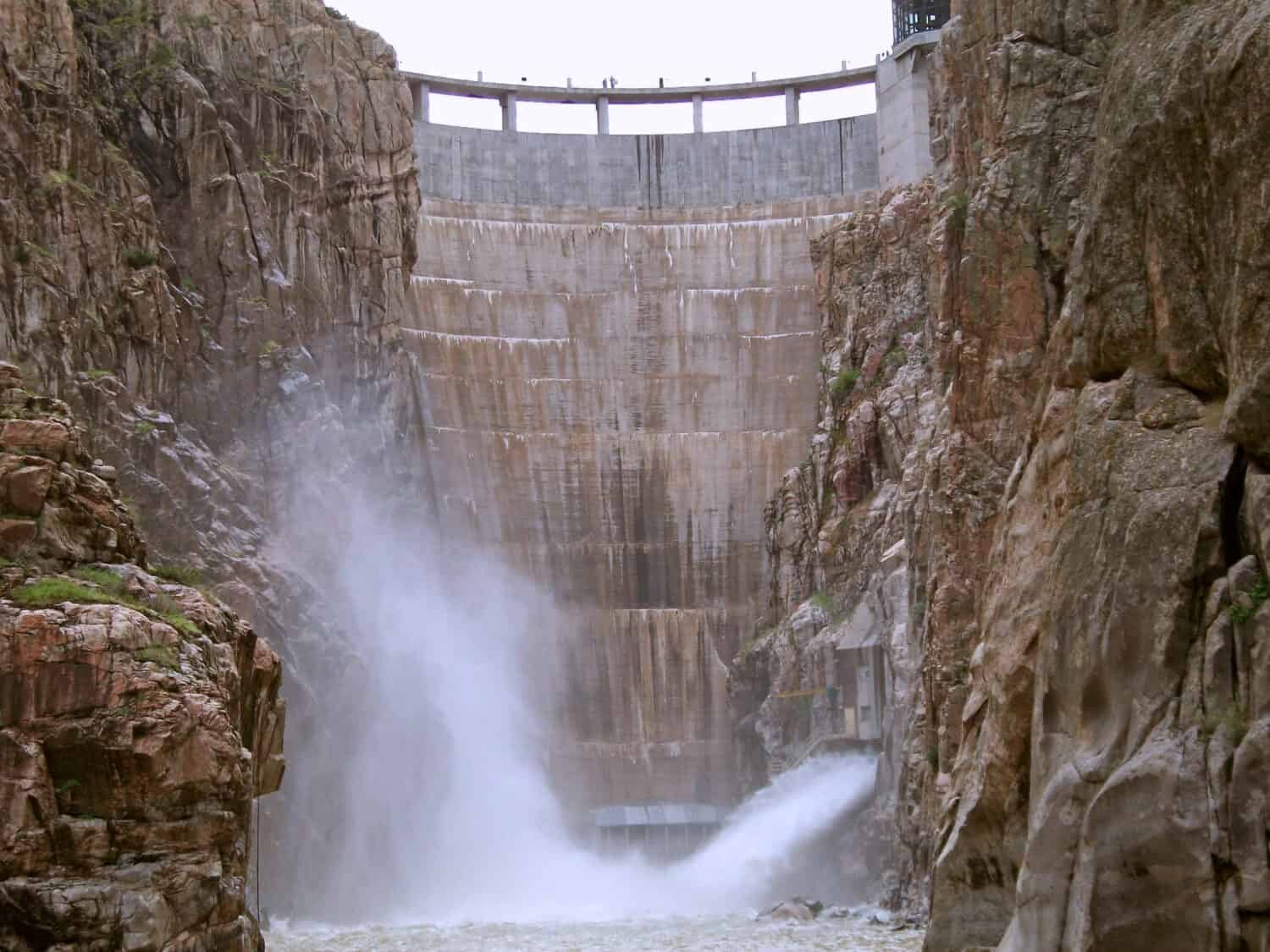The largest dam in Wyoming is Buffalo Bill Dam, which is 325 feet tall. Originally named Shoshone Dam, since it is connected to the Shoshone River, it is a major dam in the Equality State. While not the largest dam in the United States, it is still a marvel of engineering that made major changes to the flow of water in the Shoshone River to benefit nearby residents and industry.
This place is both a historic site and an engineering marvel. The National Register of Historic Places and the list of National Civil Engineering Landmarks both include Buffalo Bill Dam.
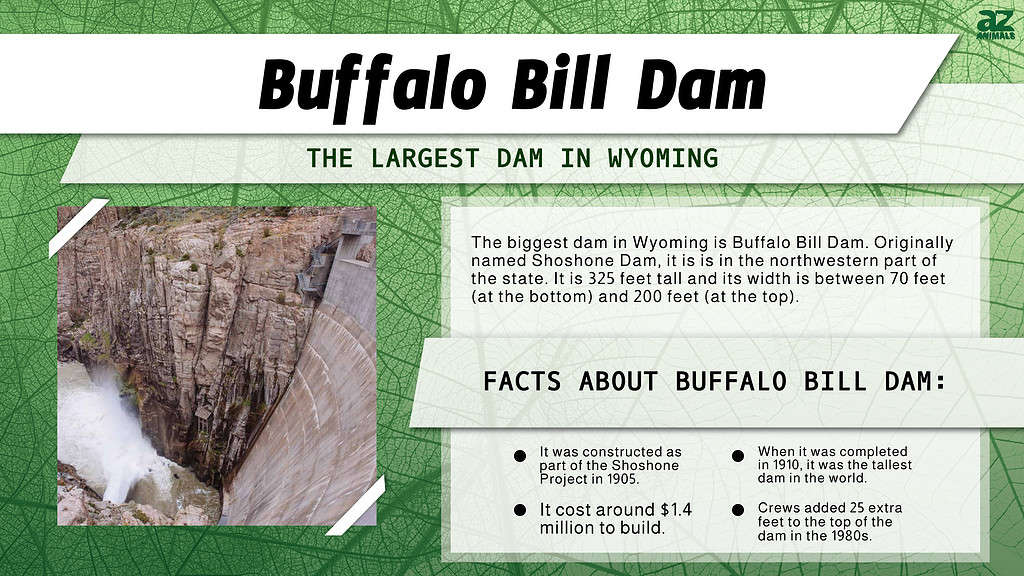
Where Is the Buffalo Bill Dam?
The Buffalo Bill Dam is in the northwestern part of Wyoming in the Shoshone River. The Shoshone River is around 100 miles long and flows into the Bighorn River, which eventually flows into Yellowstone. The river begins in the Shoshone National Forest, a 2.5 million acre area that is protected. Wyoming has many rivers, including some of the most pristine in the United States.
The dam is made of concrete. It is between 70 feet (at the bottom) and 200 feet (at the top) wide. Granite on either side of the dam provides an anchor point. The dam has an arched concrete design.
The nearest town to Buffalo Bill Dam is Cody, Wyoming. This town is named for William Cody, also known as Buffalo Bill. Cody is just 6 miles from the dam. The land where the dam is located was originally owned by Cody. He pushed to add the dam to allow for irrigation and water supply to the Bighorn Basin to grow crops. Cody also founded his namesake town. At the time when it was built, the dam was called the Shoshone Dam. Officials renamed the dam to honor Cody in 1946.
If you are headed to Yellowstone from Cody, you’ll pass right by the Buffalo Bill Dam. It is an easy (and free) stop to take photos. You can also learn more about the history and engineering of the dam and even view wildlife. Cody itself is a fun destination. The town hosts everything from rodeos to day experiences at one of the many ranches. You can get a true Wild West experience, just like Buffalo Bill. Its vast natural spaces, perfect for viewing wildlife, provide a connection to the great outdoors.
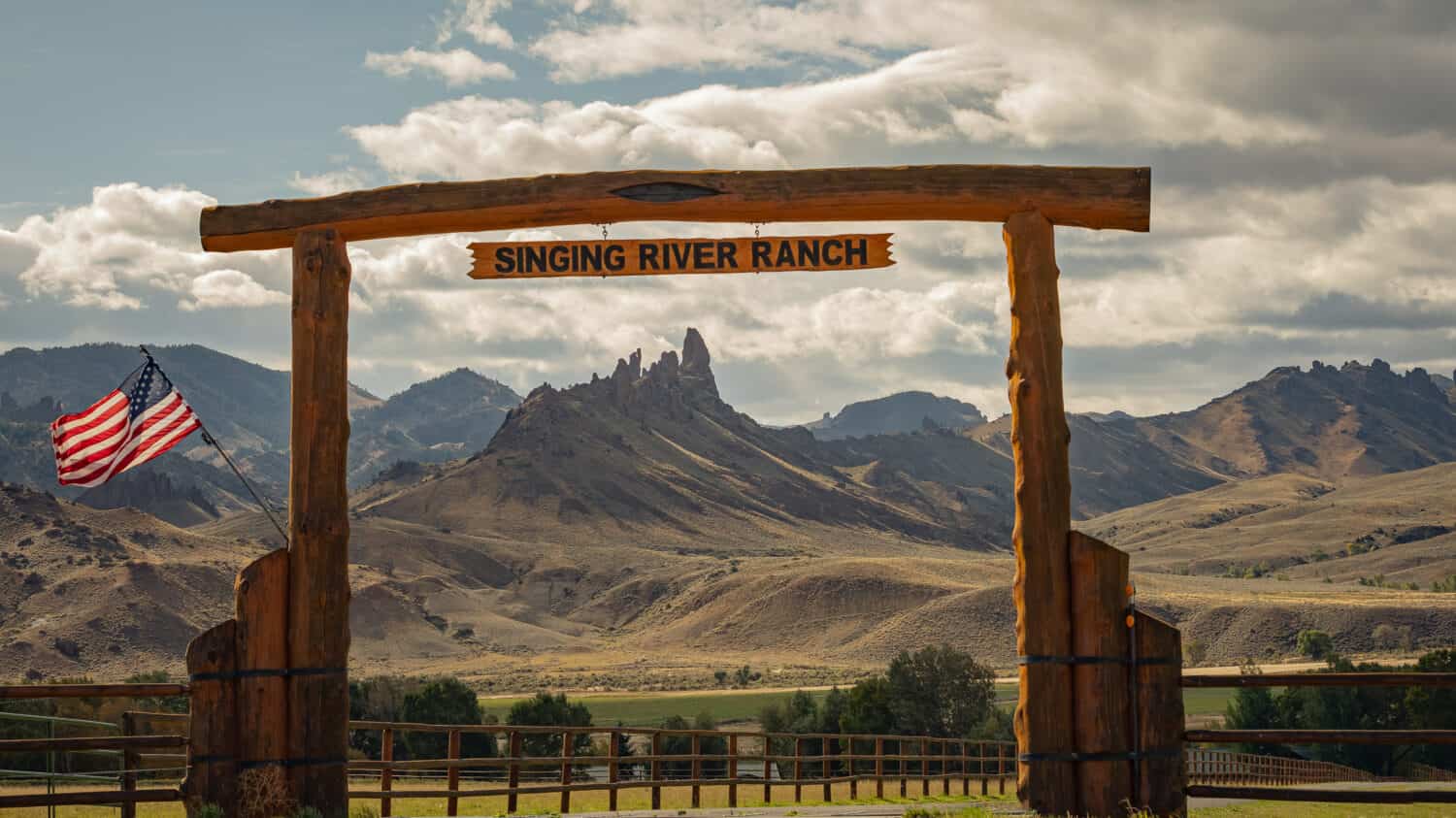
There are numerous ranches near Cody, Wyoming that provide an authentic Wild West experience.
©Johnnie Laws/Shutterstock.com
When Was the Buffalo Bill Dam Built?
The Buffalo Bill Dam was constructed as part of the Shoshone Project in 1905. It took five years to finish, in part due to flooding that set work back. The construction contractors also changed during construction after the first round of delays. Due to harsh working conditions, some of the laborers went on strike. This was the first organized strike in the state of Wyoming.
The dam was part of a larger project. Cody supported the Shoshone Project and wanted to bring it to this part of Wyoming. The Shoshone Project, including the construction of the Buffalo Bill Dam, led to the irrigation of around 93,000 acres. This allowed more crop growth, increasing supply and boosting the economy of Wyoming.
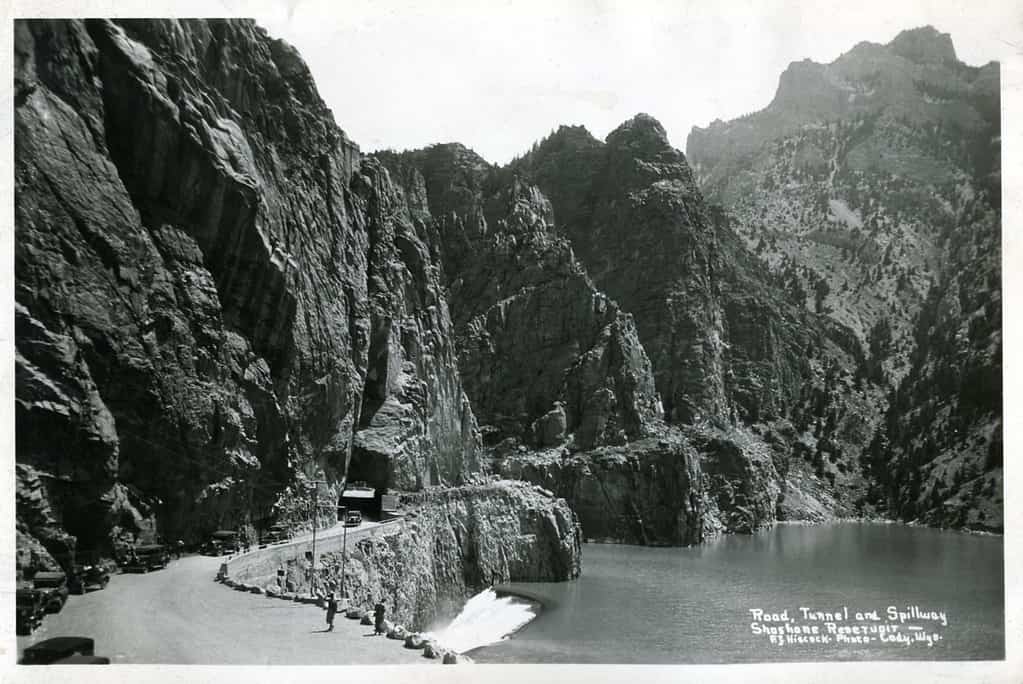
The Buffalo Bill Dam was part of the Shoshone Project of 1905.
Engineering of the Buffalo Bill Dam
When the dam was finished in 1910, it was the tallest dam in the entire world. The use of the concrete arch in the design was relatively new and something to behold. It also meant that few people had experience in building these kinds of dams. Unfortunately, construction came with its own set of challenges.
Overall, the construction of the dam cost around $1.4 million. That was an astronomical sum. But, building the dam was a major undertaking and it was vital to irrigation and agriculture in the area. Seven workers were killed during construction. Two died toward the beginning of the project during water diversion in preparation for pouring concrete. Five others died at other points during construction.
The plan called for power plants built downstream from the dam a few years later. The Shoshone Power Plant operated for more than 50 years with three power-generating units. Officials shut down two of the units when they eventually wore out and replaced the third with newer equipment. In 1937, the dam gained a tunnel to direct irrigation water to the north. Two additional workers perished during the construction of the Shoshone Canyon Tunnel.
As capacity requirements increased, the dam underwent an extension. Crews added 25 additional feet to the top of the dam in the 1980s. Another power plant, the Heart Mountain power plant, was also renovated at that time and runs seasonally. The addition of the Buffalo Bill power plant provides more power generation downstream.
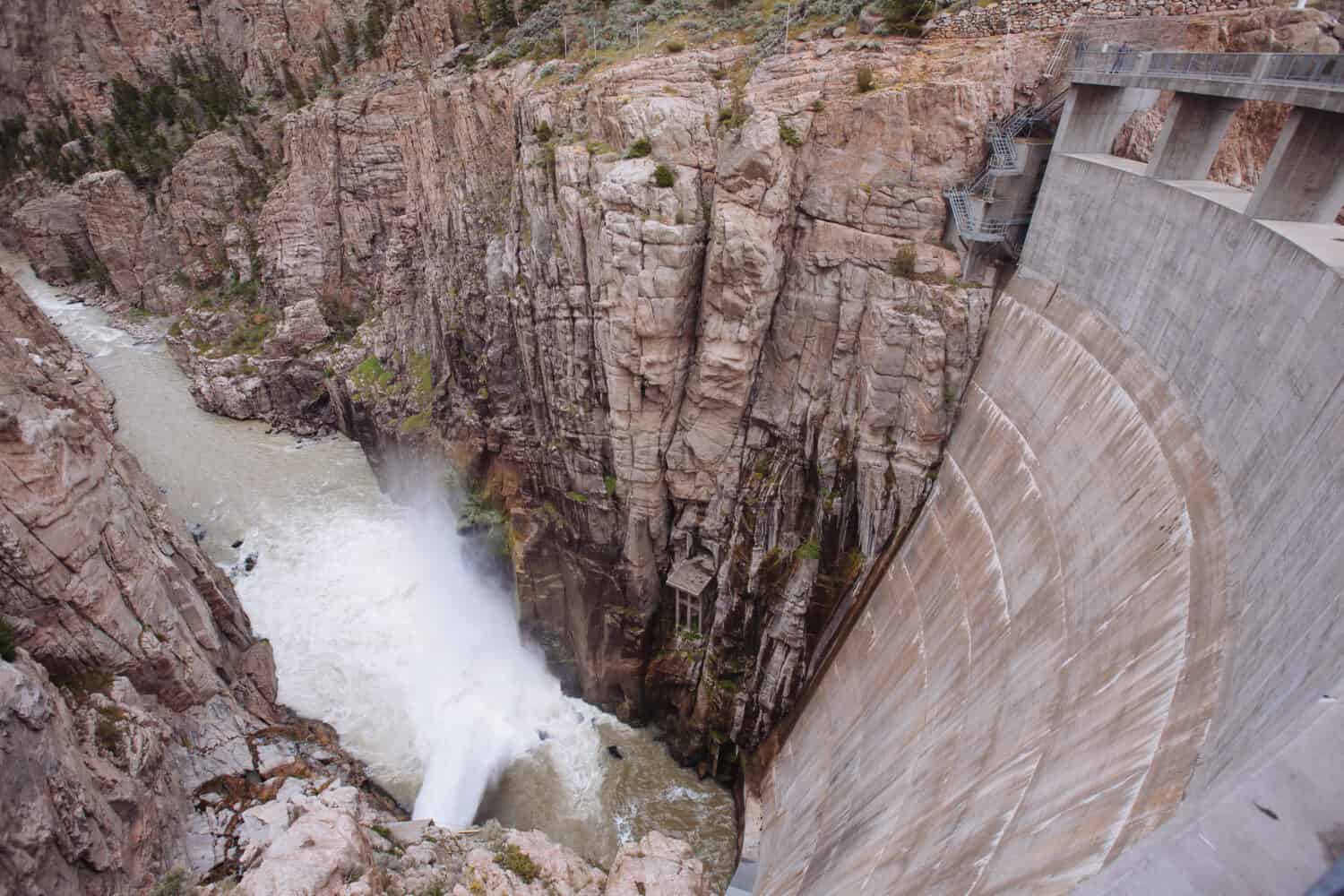
The Buffalo Bill Dam has an arched concrete design.
©Tom Robertson/Shutterstock.com
Visiting Buffalo Bill Dam
Not only is the dam a functional part of the water management system in Wyoming, but it is also a fun place to visit. Buffalo Bill Dam includes free access to the Visitor’s Center, a walking path that goes across the entire crest of the dam, and complimentary golf cart rides to and from the parking lot. If you collect National Park passport stamps, be sure to stop in the Visitor’s Center for a free stamp (or to pick up a National Park passport book if you don’t have one yet). You can also walk your pet along the top of the dam on a leash, although only service animals can go inside the visitor’s center.
Because the dam is a convenient stop on the way to Yellowstone National Park, it’s quite popular and great for stretching your legs. You can park near the visitor’s center in most cars and trucks. However, RVs and other oversized vehicles have to park in a designated place further away. Fortunately, a courtesy shuttle runs between the further parking areas and the visitor’s center.
Those interested in the engineering that goes into a major undertaking like dam construction can check out the posted signs and Interpretative Areas along the dam. They detail what the construction process was like. The exhibit includes information about the considerations that went into its design and the upkeep required to make sure it functions properly. There is also a short video in the Visitor’s Center with fascinating footage and photos from those days.
For those who just can’t get enough of the Buffalo Bill Dam and live in the area, there are volunteer shifts available in the summer months. Volunteers drive visitors to and from the parking lot in the courtesy shuttle. Special events, such as Big Dam Day in August, allow visitors to see and hike around the dam and learn more about this amazing place.

The land where the dam is located was originally owned by William Cody, known as Buffalo Bill.
©rozdemir01/iStock via Getty Images
Wildlife Near the Buffalo Bill Dam
Wyoming is home to some of the most amazing animals in North America. Many parts of the state remain unchanged from their natural landscape, which is one reason wildlife is so abundant. Large animals, such as grizzly bears, black bears, bison, and moose, are not uncommon. While they prefer to keep their distance from people and large towns, don’t be surprised if you come across one as you enjoy the great outdoors. As with all animals, you should always keep your distance and do what you can to not disturb or disrupt the animals.
Deer, mountain sheep, elk, and bears often venture near roads. Take care when you are driving in Wyoming and never get out of your vehicle to get a better look at a wild animal.
You should also keep your eyes pointed to the skies to get a glimpse of some of the amazing birds of Wyoming. Small songbirds include finches, flickers, meadowlarks, and bluebirds. Larger birds, such as hawks, owls, and loons are also residents of Wyoming. The area immediately surrounding the Buffalo Bill Dam may be difficult for some animals to access but if you venture out a bit, you’ll probably see all kinds of wildlife. There are also two wildlife cameras in the area so you can enjoy footage even if you can’t get to the dam in person.
If you want to learn more about the wildlife of Wyoming, a stop by the Buffalo Bill Dam Visitor’s Center includes access to a wildlife exhibit as well as knowledgeable volunteers and staff.
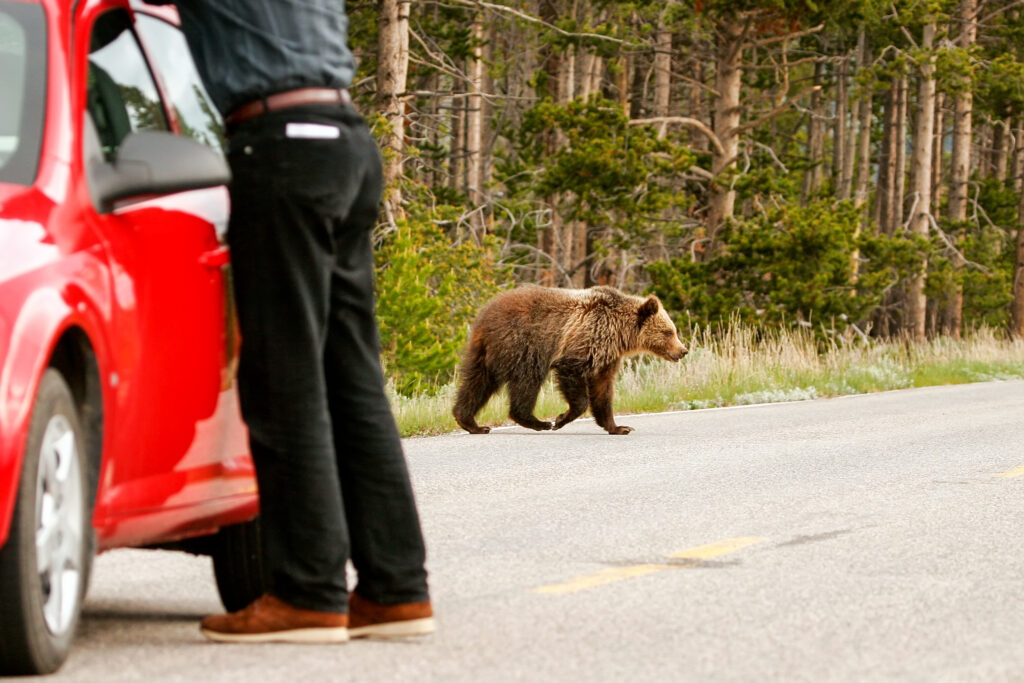
Grizzly bears, black bears, bison, and moose are among the wildlife found in Wyoming.
©Don Mammoser/Shutterstock.com
Thank you for reading! Have some feedback for us? Contact the AZ Animals editorial team.

